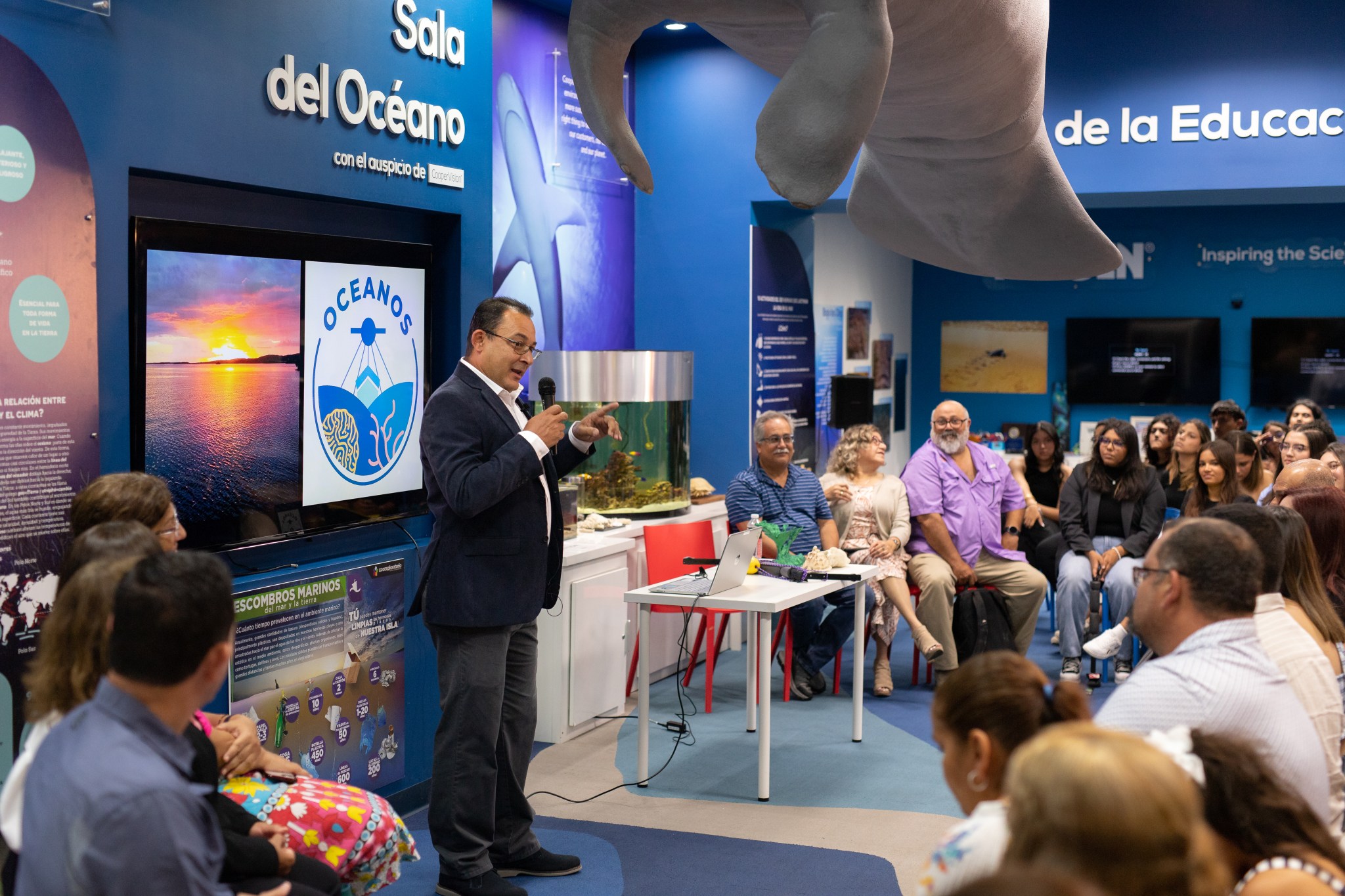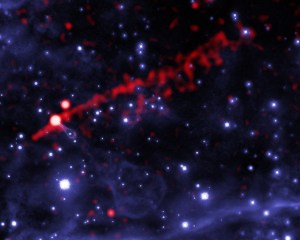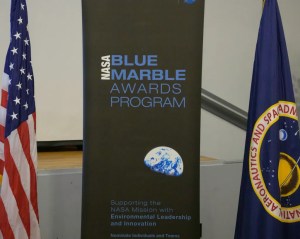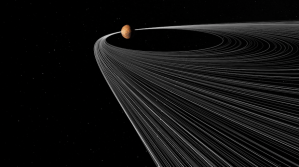OCEANOS PI Juan Torres-Perez delivers the opening address of the final presentations to a crowded room at the EcoExploratorio: el Museo de Ciencias de Puerto Rico.
Photo by: Milan Loiacono
Listen to the interview with Juan here:
0:00 / 0:00
The History
OCEANOS, ‘Ocean Community Engagement and Awareness using NASA Earth Observations and Science for Hispanic/Latino Students,’ is a bilingual, four-week internship program based in Puerto Rico. The OCEANOS mission is to bring oceanography and STEM opportunities to the historically underrepresented Hispanic/Latino communities, focused on graduating high school seniors and first generation undergraduate students.
The program’s founder, NASA Ames Research Scientist Juan Torres-Perez, said the original idea came out of his time in graduate school at the University of Puerto Rico, working with local communities and schools by giving tours of coral reefs and mangroves. In that time, he was stunned to learn how little most of his guests knew about the ocean, despite living on an island.
“It’s incredible because Puerto Rico is an archipelago. The main island is a relatively small island, 100 by 35 miles, and about 50% of the population don’t swim. Even less percent knows what’s down there. And how can you protect what is down there if you don’t even know what it is?”
After receiving a science activation grant to create the program, Torres-Perez set out recruiting co-PIs from mostly local universities and organizations, across a spectrum of skill sets and specialties.
“I’m really grateful that I have we have a really great group of people. Most of them are local from Puerto Rico. … We have people who have expertise in remote sensing. Some other people have more of a marine ecologist [background]. Some of them are more into statistics. So we wanted to come up with the idea of what would be the main topics that we wanted to cover throughout the whole internship. They were definitely key in helping putting all of that together. It was a lot of hard work, but we did it.”
Together, Torres-Perez and his team created the program structure, decided on research topics, and coordinated field work opportunities. In planning the curriculum, OCEANOS staff was focused on imparting a mix of technical and soft skills. On the scientific side; “We definitely wanted for them, at the end of the of the internship, to have a fairly good idea about coastal tropical marine ecosystems. [Some of this came through] the use of NASA Earth observations and remote sensing to study water quality and to study marine ecosystems in general. Also, to give them the opportunity to actually build a low cost water quality instrument from scratch and actually test that instrument against state of the art optical instruments.”
In terms of soft skills, Torres-Perez said he hoped the students would learn teambuilding, and was amazed at how quickly that integration occurred after starting the program as 20 strangers. “You could tell even towards the middle of the internship; they were already treating each other as if they’d known each other for years even though they’d only met a couple of weeks before.”
The Program
The program kicked off at the beginning of June, with the first week dedicated to classroom instruction at the Interamerican University in San Juan, Puerto Rico. Torres-Perez taught a module on oceanography, comprising its biological, chemical, physical, and geological components, as well as an introduction to remote sensing. Co-PIs and guest speakers covered related topics, such as marine ecosystems, the basics of GIS, the GEE (Google Earth Engine) and associated programming/coding, and water quality monitoring.
The second and third weeks of the program introduced the students to field work, focusing on the vibrant coral reefs in La Parguera and Culebra. Torres-Perez, a trained divemaster with over 30 years of diving experience, together with the staff of SAM (the Sociedad Ambiente Marino), led expeditions to the reefs. The instructors taught students to find and identify organisms living in the reefs, and trained the group on the general ecology and framework of the ecosystem. One highlight for Torres-Perez was watching the students’ fascination with the reefs.
“When we were in the water in particular, about anything that they would see: ‘what is this? What is that?’ You know you have the student’s attention when you have the student through the whole day in the field or in the lab or in a classroom setting, and by 6 p.m. they’re still asking questions and they don’t want to leave.”
Many of the students had never snorkeled before, and some of them had never swam. “There was one student that was particularly scared of the water, and especially being in the water at night. One of the things that we do in the southwest is that we bring them to the bioluminescent bay; [we] put a life vest on her and she jumped in the water. And then by the end of that, she was actually quite thankful. She said, ‘thank you guys, because one of the reasons why I applied to OCEANOS is to see if I could overcome this [fear]. And I did it.’ ”
The final week of the program was dedicated to the creation of storymaps; an interactive way for students to visually present their findings. Each group of four, two high schoolers and two undergraduates, presented a specific topic using a combination of academic research, field research, and analysis. On Friday, June 30, the OCEANOS students presented their storymaps at the EcoExploratorio: Museo de Ciencias de Puerto Rico in San Juan, Puerto Rico, to an audience of friends, family, museum staff, and NASA personnel.
The Future
Reflecting on the pilot year after dedicating so much time and energy to planning, Torres-Perez was proud.
“It’s a dream come true for me. [I’ve] been thinking about this for a very, very long time. And to bring this opportunity to students, especially low income students or students from the local public high schools in the island, or even first generation students at the university level; the idea was to give them this opportunity to see that they can build a career in areas related to science, to technology, to engineering, to mathematics, and especially in oceanography or marine sciences.”
Despite the success of the first year, Torres-Perez is already thinking about ways to improve the program moving forward. Based on a combination of experience and feedback, he is considering modifying the structure to include more hands-on work from the beginning, and in particular more time in the water. Year two of OCEANOS is already set to increase the number of participants, from 20 up to 40. Meetings with co-PIs throughout this next year will address potential changes to the curriculum, as well as logistical adaptations to accommodate the larger group size.
Under the applied sciences grant, OCEANOS is set to run for two more years. Beyond that, Torres-Perez is considering the ways the program can be applied more globally.
“We really started the conversations among the co-PIs to see what would our OCEANOS 2.0 would look like, or where we can expand it to. We’ve been thinking about other jurisdictions in the US, not necessarily Hispanic or Latino jurisdictions: Pacific Islanders and some others who have similar ecosystems as Puerto Rico, but [who] also have the same difficulties as well.”


































